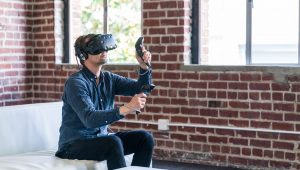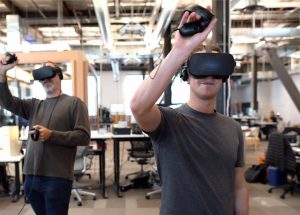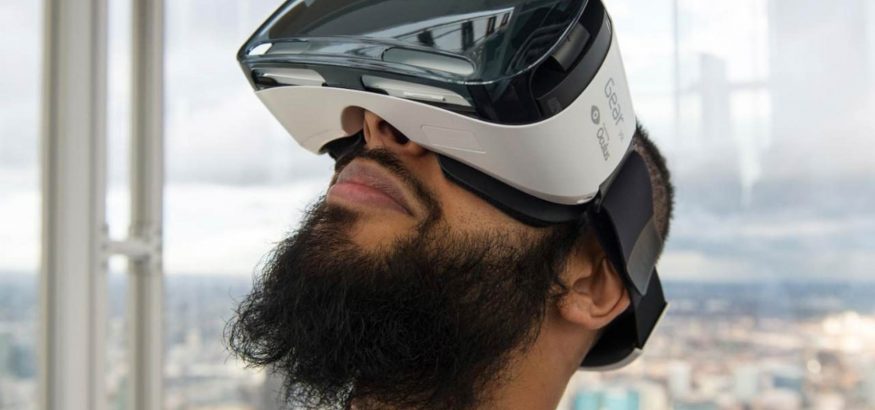Virtual Reality: Exploring The Business Applications
For decades, we have dreamt of transporting ourselves to alternate realities with the power of virtual reality (VR). As the hardware and software needed to create truly immersive, three dimensional worlds becomes more inexpensive and accessible, that dream comes ever closer to reality.
Once widely perceived as nothing more than a gimmick and a toy, VR head mounted display s(HMDs) are now being taken much more seriously. In fact, last year Samsung logged over one million users for their smartphones-based HMD.
Tech behemoths Google, Microsoft, Samsung and Facebook are pouring billions of dollars into VR in a race to bring a cheap VR product to mainstream consumers. “You’re getting a level of simulation quality that might’ve been possible only in a $1 million system just 20 or even 10 years ago,” Samsung’s GM of immersive products told Fortune about VR becoming a more affordable (and thus a more easily adopted) technology.
 As the cost of participating in VR technologies rapidly diminishes, we are left with a few interesting considerations. VR has already proven itself to be rather effective as a new component of modern entertainment. Although not all the kinks are worked out, it is not a stretch of the imagination to picture VR headsets becoming a mainstay of commercial video gaming as well as other forms of interactive entertainment. What is far more intriguing is VR’s practical uses. If VR technologies continue to advance, they could become as ubiquitous as the personal computer. Without a shadow of a doubt, VR and augmented reality (AR)could enhance how we engage in work, just like the personal computer has. But, this leads to another question: what would this look like? And another: what applications would VR seep into first?
As the cost of participating in VR technologies rapidly diminishes, we are left with a few interesting considerations. VR has already proven itself to be rather effective as a new component of modern entertainment. Although not all the kinks are worked out, it is not a stretch of the imagination to picture VR headsets becoming a mainstay of commercial video gaming as well as other forms of interactive entertainment. What is far more intriguing is VR’s practical uses. If VR technologies continue to advance, they could become as ubiquitous as the personal computer. Without a shadow of a doubt, VR and augmented reality (AR)could enhance how we engage in work, just like the personal computer has. But, this leads to another question: what would this look like? And another: what applications would VR seep into first?
It was only three years ago that Facebook sunk its first $2 billion into VR when they acquired Oculus Rift, the then-burgeoning VR tech company. At a recent F8 conference, Zuckerberg provided us with a demo of the technology Facebook has been working so tirelessly on. He showcased not only its ability to transport users to constructed worlds and fantastical realms, but also its capability to augment existing places and things.
“The idea is that virtual reality puts people first. It’s all about who you’re with. Once you’re in there, you can do anything you want together — travel to Mars, play games, fight with swords, watch movies or teleport home to see your family,” he wrote in a post on social media. He highlighted mostly the social aspect of the company’s VR platform. But, in a small snippet of his demonstration, he showcased an avatar version of himself teleporting into the Facebook offices. It is quite feasible, then, that the technology could be used to augment remote work.
Remote work has been steadily rising in popularity over the past few years. Over a third of the US workforce has had some experience with it. It was predicted in the 80’s that it would become the future of work because of its manifold benefits. Virtual work has not yet become the norm, however, due to a few roadblocks. Namely, isolation is a major issue for telecommuters. VR, would, in effect, address the lack of social interaction remote workers experience.
Already, there are technologies such as Beam, which allows for telecommuters to report in to the office as a small screen on wheels. University of Pennsylvania engineering students have taken the technology a step forward with VR. They’ve created a roving robot equipped with 3D cameras. Users can “inhabit” the body of the robot using a VR headset.
According to the engineering students, testers of their technology have been able to conduct conversations and engage in rudimentary social interactions. If telepresence robots could indeed become a reality, remote work could resemble something very similar to how we define work presently — only without geographical constraints. Video conferencing and business meetings could likewise be met with radical transformations due to VR, as more impersonal methods of interacting would no doubt become obsolete.
 VR could change more than how we define being present. “Our mission is to give anyone the power to express anything they’re thinking about or want to experience,” Zuckerberg explained about the company’s vision for the future of AR and VR at a live talk he hosted from Berlin. “I think that’s going to be really profound: not only being able to capture real things in a much more visceral way, but being able to construct different things that wouldn’t be possible.” As Zuckerberg illuminated in his chat, VR can alter our world instead of merely transporting us. What does this mean in terms of business applications? How we visualize, conceptualize and test important ideas and data could be totally changed.
VR could change more than how we define being present. “Our mission is to give anyone the power to express anything they’re thinking about or want to experience,” Zuckerberg explained about the company’s vision for the future of AR and VR at a live talk he hosted from Berlin. “I think that’s going to be really profound: not only being able to capture real things in a much more visceral way, but being able to construct different things that wouldn’t be possible.” As Zuckerberg illuminated in his chat, VR can alter our world instead of merely transporting us. What does this mean in terms of business applications? How we visualize, conceptualize and test important ideas and data could be totally changed.
Big data, for instance, could be more easily digested in a 3D realm, where researchers physically explore trends and data points rather than simply reading off facts and figures from sheets of numbers and graphs. According to one researcher, she was able to absorb around four times as much information utilizing VR as opposed to her traditional methods of analyzing data sets.
Testing and prototyping could be revolutionized as well. The Ford Motor Company has reportedly been using VR since 1999 in order to more efficiently prototype vehicles and test ideas. “The impact on cost, time and quality are significant, and have allowed our designers and engineers more creative freedoms to explore options that in the past would have been to time- or cost-intensive to consider,” Ford’s senior technical leader said.
The automotive industry isn’t the only industry that could stand to benefit from VR, either. Programmers, designers and data scientists could all use the technology to break free of processing information from 2D sources, such as laptop screens and paper reports.
VR is already reshaping how we interact with media. Tech companies have recognized the massive growth potential of VR and AR technologies and are working hard to produce a VR product suitable for mass consumption. As adoption rises, it seems likely that these technologies could change remote work, and telecommunication in general. Telepresence is only the beginning. How we conceptualize, train and engage in work could be enhanced (and maybe even reimagined). Some members of the automotive industry, such as Ford, have already recognized the merits of VR as a tool and have integrated it into its prototyping process. Indeed, VR’s applications are seemingly infinite. We only need to find out how to properly navigate the changes it will most certainly bring.








